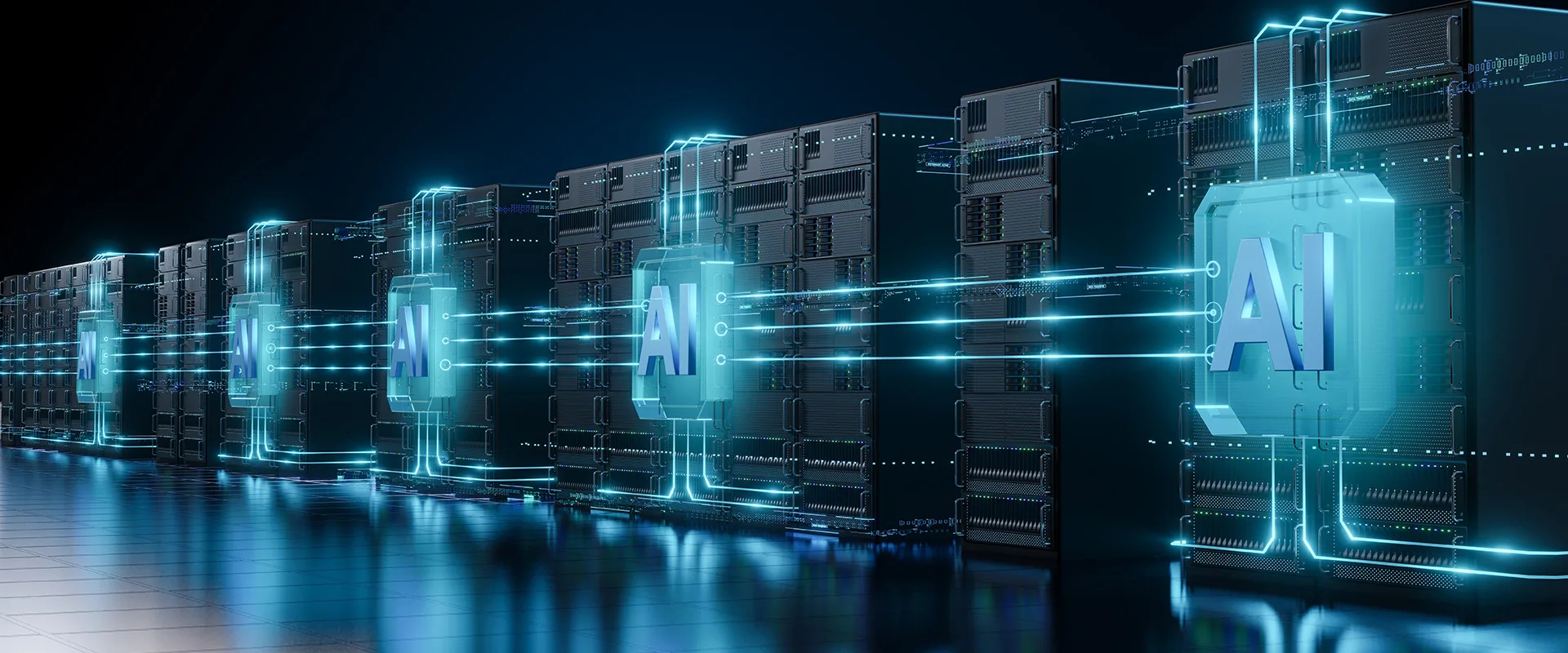AI models process massive datasets and perform complex calculations. This places different demands on a data center compared to traditional IT environments. In practice, an AI data center is not fundamentally different from a traditional data center. However, it must offer the right facilities and capabilities to support AI workloads. Think of alternative cooling methods and high-density environments.
Specialized hardware in an AI data center
Whereas standard servers primarily use CPUs (Central Processing Units), AI workloads rely on specialized hardware such as GPUs (Graphics Processing Units) and AI accelerators, like Google’s TPUs (Tensor Processing Units). These chips are optimized for handling complex tasks, such as image recognition in healthcare or real-time data analysis in traffic management to predict and reduce congestion.
This powerful hardware generates significantly more heat and consumes more energy than traditional servers. It also places greater demands on data exchange between systems. These factors impact both the physical and technical infrastructure of the data center.
Power consumption and cooling in an AI data center
AI servers can consume hundreds of watts per unit. Peak loads can push energy demand even higher. This creates new challenges for AI data centers, especially in terms of power supply and cooling.
High-density computing: more processing power per square meter
To get the most computing power out of a limited number of racks, systems are increasingly deployed in high-density configurations. This means more power per rack and therefore a higher energy demand per square meter.
In traditional data centers, power usage typically ranges from 3 to 12 kW per rack. In AI environments, racks can easily reach 100 kW. This results in a higher constant load, as well as spikes during intensive AI training sessions.
An AI data center must be equipped with a power infrastructure that can handle these demands. It also needs to provide enough capacity and be ready for future growth. Without this flexibility, power supply can become a limiting factor for scaling up and supporting growing AI workloads.
Efficient cooling to prevent throttling
Without effective heat removal, AI chips may automatically reduce performance to avoid overheating. This process, called throttling, lowers the efficiency of AI workloads and increases training time.
Air cooling is sufficient in many traditional data centers. However, for AI workloads, it may not be adequate. That is why an AI data center should be prepared for alternative cooling methods. Solutions like liquid cooling or immersion cooling remove heat more effectively and support higher power densities.
Want to learn more about alternative cooling? Read our blog: Immersion cooling and liquid cooling: the future of AI data centers
Sustainability as a requirement for AI data centers
Because AI hardware consumes a large amount of electricity, the use of 100% renewable energy is not optional. It is a requirement. Data centers play a crucial role by sourcing green energy through Guarantees of Origin. This often takes place through long-term power purchase agreements (PPAs) with wind and solar farms. Using green power helps reduce the ecological footprint of AI workloads and contributes to a stable energy supply.
In addition, energy-efficient cooling technologies and heat reuse are becoming increasingly important:
- Advanced cooling systems reduce overall energy consumption. This means less electricity is needed compared to traditional cooling.
- AI workloads produce a large amount of residual heat. This heat can be reused for district heating or industrial purposes. It helps lower total energy demand and supports a circular economy.
Robust network infrastructure in an AI data center
AI workloads require fast and reliable data exchange between systems. That’s why the network infrastructure in an AI data center must be designed for low latency, high bandwidth, and maximum availability. When choosing a data center, it’s important to consider the following points:
- Carrier and cloud neutral. A carrier- and cloud-neutral data center allows you to choose from multiple network providers and cloud platforms. This makes it easier to build a hybrid AI infrastructure. Sensitive data stays securely in the data center, while additional services can be deployed flexibly from the cloud.
- Modern fiber infrastructure and scalable network architecture. Fast and stable data connections are critical for AI workloads. An AI data center should have a modern fiber-optic network and a scalable architecture. This ensures that it can handle growing data flows and maintain low latency.
Data sovereignty and AI: control over data storage and processing
As AI is increasingly used for critical and privacy-sensitive applications, data sovereignty is becoming more important. Organizations want full control over where and how their data is stored and processed. They do not want to rely on foreign laws or jurisdictions. AI training often involves sensitive datasets, such as medical records or intellectual property. This makes data control essential.
An AI data center must therefore meet the following requirements:
- Strict security standards, such as ISO 27001, to protect the physical and digital infrastructure.
- European data sovereignty, so that data remains within Europe and organizations are not fully dependent on non-European cloud providers.
An AI data center is an optimized data center
An AI data center is, at its core, an optimized data center. It must support high-density environments, alternative cooling methods, fast networking, and a sustainable power supply. When selecting an AI data center, it’s essential to consider where your data is stored and processed. An infrastructure that can grow with your needs is just as important.
